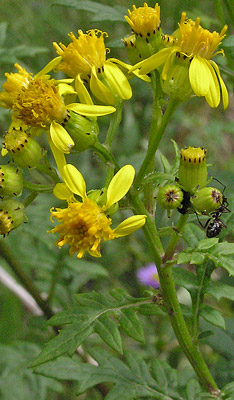Senecio
|
Family: Asteraceae |
Annuals, biennials, perennials, subshrubs, or shrubs, 5-100(-250+) cm (perennating bases taprooted, fibrous-rooted, branched caudices, or suberect to creeping rhizomes; roots often fleshy, seldom branched; herbage glabrous or hairy, often glabrescent at flowering). Stems single or clustered, erect to lax (simple or branched). Leaves basal and/or cauline; alternate; petiolate or sessile (bases sometimes clasping); blades subpalmately to pinnately nerved, mostly ovate or deltate to oblanceolate, lanceolate, linear, or filiform (and most intermediate shapes), rarely suborbiculate (sometimes palmately or pinnately lobed to 2-3-pinnatifid), ultimate margins entire or denticulate to serrate or toothed (sometimes with relatively many callous denticles or teeth), faces glabrous or hairy (usually arachnose to tomentose, often glabrescent). Heads (sometimes nodding) usually radiate or discoid (rarely quasi-disciform), usually in corymbiform to cymiform, sometimes paniculiform or racemiform, arrays (sometimes from axils of distal leaves), sometimes borne singly. Calyculi usually of 1-8+ bractlets (bractlets often intergrading with distal peduncular bracts, mostly 1 / 5 - 1 / 2 + times phyllaries), sometimes 0. Involucres mostly cylindric or turbinate to campanulate, 5-15(-40) mm diam. Phyllaries persistent, usually ± 5, 8, 13, or 21 [34] in (1-)2 series, distinct (margins interlocking), erect (often reflexed in fruit), mostly oblong to lanceolate or linear, subequal or equal, margins usually scarious. Receptacles flat to convex, foveolate, epaleate. Ray florets usually ± 5, 8, 13, or 21 [34], pistillate, fertile, sometimes 0; corollas usually yellow, sometimes ochroleucous or white, rarely reddish to purplish (laminae sometimes barely surpassing phyllaries; peripheral pistillate florets usually 0, sometimes 1-8+; corollas usually yellow, sometimes ochroleucous or white). Disc florets (5-)13-80+, bisexual, fertile; corollas usually yellow, rarely ochroleucous, white, reddish, or purplish, tubes shorter than to equaling campanulate throats, lobes 5, erect to recurved, usually ± deltate; style branches stigmatic in 2 lines, apices usually truncate-penicillate. Cypselae cylindric or prismatic, usually 5-ribbed or -angled, glabrous or hairy (especially on ribs or angles, hairs sometimes myxogenic); pappi usually persistent (fragile), sometimes readily falling, of 30- The concept of Senecio in traditional North American floristics stems from nineteenth century botanists who saw the genus as a diverse assemblage held together by similar morphologies of the heads and florets. Studies in the past two decades have shown Senecio in the broad sense to be a collection of separate lineages; a better taxonomy is to be had by treating the lineages as genera. Some of the lineages were recognized in the past as infrageneric assemblages. A treatment of Senecio by T. M. Barkley (1978) reflected the traditional circumscription of the genus; a narrower circumscription is used here. Present concepts, plus a catalogue of genera, were presented by Barkley (1999). The 'species-groups' recognized here are given names purely as a matter of convenience; the groups and their names are intentionally given no formal taxonomic status (T. M. Barkley 1978). Some of the groups may represent natural evolutionary alliances; that remains to be clarified. The following taxa are not established members of the flora but are nonetheless noteworthy: Senecio brasiliensis (Sprengel) Lessing var. tripartitus (de Candolle) Baker is a South American weed of disturbed sites, introduced on the Gulf Coast near Pensacola, Florida, in 1893-1894. Its presence was discussed by J. M. Greenman (1917) and by L. J. Uttal (1982), both of whom treated it as Senecio canabinaefolius Hooker & Arnott. It is toxic to livestock; it seems not to have persisted in the flora. Senecio bicolor (Willdenow) Viviani (S. cineraria de Candolle) is one of the plants called 'dusty miller' in the horticultural trade. It occasionally persists in the flora after cultivation. Species of the African genus Euryops are commonly cultivated in California and Florida and, to a lesser extent, in other warm areas of the flora. They would key here to Senecio. They are shrubs with leaves dissected or prominently toothed, phyllaries connate for the proximal third of their lengths, and yellow corollas. Apparently none persist for long after cultivation. Relatively recent collections from low-lying (50-100 m), seasonally wet, disturbed areas in Orange and San Diego counties, California, have included semi-weedy perennial herbs or subshrubs 100-200 cm that are initially arachnose to tomentose, soon glabrescent, and have oblanceolate to linear or filiform leaves (2-7 cm), notably small heads in corymbiform arrays, ± 13 phyllaries 3-4 mm, and Heads radiate or sometimes discoid, the rays pistillate and fertile, yellow to orange or occasionally reddish, invol bracts ±herbaceous, essentially equal, uniseriate or subbiseriate, often with some bracteoles at base; receptacle flat or convex, naked; disk- fls perfect and fertile, yellow to orange or reddish; style-branches flattened, truncate, penicillate; achenes subterete, 5-10-nerved; pappus of numerous, usually white, entire or rarely barbellulate capillary bristles; herbs (ours) or sometimes woody plants, with alternate (or all basal), entire to variously dissected lvs and mostly small to medium-sized heads. 1000+, cosmop. Spp. 4-14 ill- defined, their chromosomes also subject to miscount because of B-chromosomes. Gleason, Henry A. & Cronquist, Arthur J. 1991. Manual of vascular plants of northeastern United States and adjacent Canada. lxxv + 910 pp. ©The New York Botanical Garden. All rights reserved. Used by permission. |

